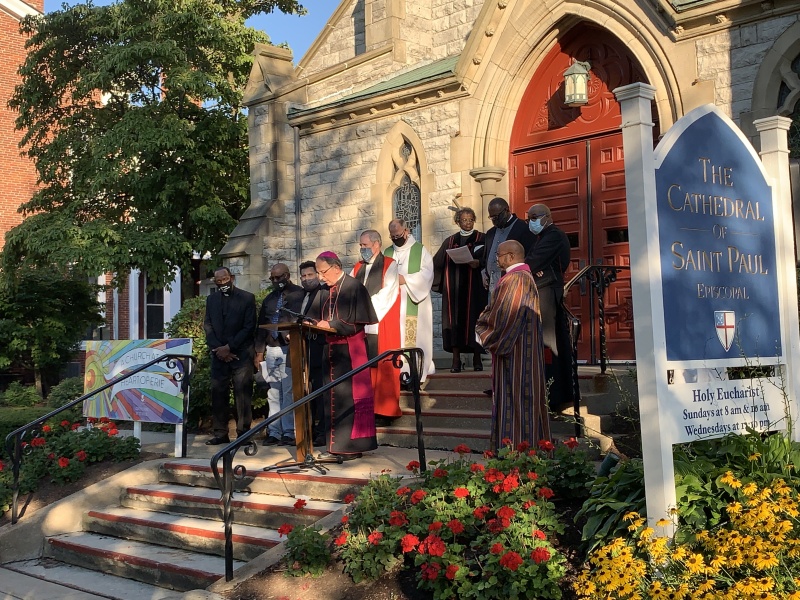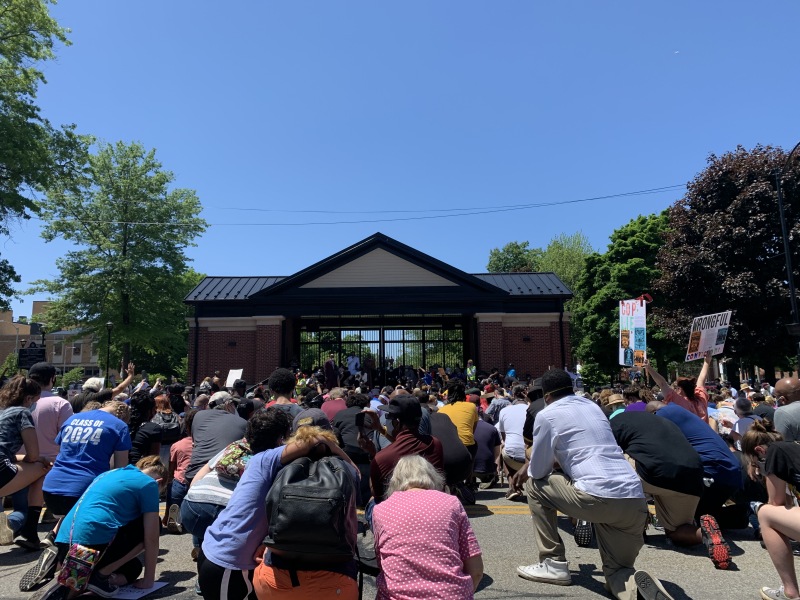
THREE BISHOPS, BLACK AND WHITE, CONTINUE TO ADVANCE ERIE'S RACIAL RECKONING
03/08/2021
The Rt. Rev. Sean Rowe, bishop of the Episcopal Dioceses of Northwestern Pennsylvania and western New York; The Most Rev. Dwane Brock, bishop of the Victory Christian Center; and The Most Rev. Lawrence Persico, bishop of the Catholic Diocese of Erie, authored the following op-ed that was published by the Erie Times-News on Sunday, March 7, 2021.
ERIE — As three Christian leaders committed to racial justice in Erie, we are accustomed to looking for hope in the midst of despair. So far, 2021 has offered us plenty of opportunities to search: the Jan. 6 insurrection at the U.S. Capitol that featured strong white supremacist elements, a slow vaccine rollout rife with racial inequities and ever-widening racial disparities among students learning online. But just as Lent, the season in which we Christians now find ourselves, always ends with Easter, so we believe that faithfully facing into today’s grim racial reality can lead us to a season of deeper racial reconciliation in our city than any we have ever experienced.

an ecumenical Prayer Service of Reconciliation hosted by United
Clergy of Erie Aug. 7. Photo/Anne-Marie Welsh
Erie’s history of race and religion is grim. Nearly 100 years ago, white Protestant church leaders here openly embraced the Ku Klux Klan, celebrating the white supremacist organization as a charitable organization devoted to law and order. Within our living memories, the Klan and other white supremacists have terrorized Black churches in Erie and fanned the fires of racism. For far too long, white religious leaders, particularly mainline bishops and pastors, hid behind their pulpits, remaining silent as their Black colleagues were harassed, threatened and excluded from civic leadership.
But last summer, that changed. Just days after George Floyd was murdered by police officers in Minneapolis, Bishop Dwane Brock convened us — three bishops, one Black and two white — to hold a public vigil exhorting the people of Erie to respond with solidarity and peace. With just a few days’ notice, more than 2,700 people gathered for a peaceful, silent march against racism. At the event, our city’s chief of police got down on one knee, publicly affirming that Black lives matter and stating unequivocally that racism would not be tolerated in Erie. Political and business leaders in the region echoed his commitment. In a city that ranked as one of 24/7 Wall St.’s worst cities for Black Americans in 2019, this outpouring of support for racial justice was unprecedented.
The response galvanized us, too. Since June, we have met regularly to wrestle with the issues that have long divided our city and the mistrust and resentment caused by longstanding racial divisions in Erie’s religious community. In August, we once again called people together to pray for racial justice, this time on the steps of the Episcopal cathedral which has long been identified with Erie’s elite white community. At that service, the two of us who are white committed to examining the ways in which we benefit from the sin of racism and changing the systems that oppress and kill our Black siblings.
This past fall, we met with people across our community, asking hard questions about how implicit bias and systemic racism have resulted in dramatic disparities between Black and white Erie residents in health, education and overall well-being. By listening to leaders and community members, we have identified three urgent issues that we must address in order to help repair the breach in our city.

for two minutes in Perry Square at the end of the event.
Photo/Sheila Grove
Perhaps no system in our community bears the scars of generations of neglect and discrimination more than the public schools in the Erie School District. An inequitable state funding formula in place for decades means that in the 2017-2018 school year, the Erie district, where 59 percent of students are not white, received just $5,570 in local tax revenue to educate each of its students annually, while nearby Fairview, where 90 percent of the students are white, received $11,308 in per capita local tax support. Funding reforms passed by the Pennsylvania General Assembly helped rectify this enormous disparity, but only for new tax money. So, despite promising headlines and infusions of both state and federal aid, the Erie public schools continue to struggle against a funding formula that reinforces historic white advantage. We cannot stand idly by while the future of our city’s children is foreclosed by the institutional racism embedded in the state’s so-called fair-funding formula.
Our criminal justice system must also change. As bishops, we have noted the vast arrest and sentencing disparities that rip apart our city’s Black families and communities. The Vera Institute of Justice reports that in Pennsylvania, Black people make up about 11 percent percent of our state’s residents, but account for 37 percent of our jail population and 47 percent of our prison population. Implicit bias in policing and the justice system plays a part in creating and perpetuating these kinds of gross disparities. But for decades, our systems of cash bail and mandatory sentencing minimums have resulted in a penal system that author Michelle Alexander calls the new Jim Crow, and they must change. We are grateful that Erie Police Chief Dan Spizarny, Erie County Judge John Trucilla, and other Erie leaders in our city have also committed to addressing these disparities at a local and state level. As men of faith, we cannot continue watching the God-given human potential in our communities be crushed by an unjust justice system.
The enormous wealth disparity between Erie’s white community and our communities of color is both the cause and effect of our city’s long history of systemic racism, and nowhere is that gap more evident than in our white mainline churches. Many of our congregations and dioceses were enriched by donations from members whose families made their wealth initially in the slave trade, and then in banks that enforced redlining, in corporations that exploited Black workers, and in other practices that enriched white people at the expense of people of color. While our churches strive toward equity and justice today, there is no question that our ministry in many communities is possible only because of historic wealth stripped from Black people and communities. This ugly history is part of the reason that our glorious churches, like the cathedral on whose steps we stood in August, have always been too white, and that too many of our historically Black congregations came into being because their members were excluded by their white siblings in Christ. We are committed to repairing that breach by urging our church leaders and others who steward Erie’s corporate and institutional wealth to find and fund sustainable, effective programs that can eliminate the wealth, health and education gap faced every day by people of color in Erie.
In 2020, we helped change history when we walked the streets of Erie arm-in-arm, pledging to make our city a more just place. In 2021, we must deliver on the promises we made, ensuring that in future years, the people of Erie can tell a new kind of Black History Month story about the time when Christians refused to stay silent in the face of the sin of racism.
-
